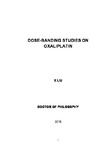Dose-banding studies on oxaliplatin
| dc.contributor.supervisor | Sewell, Graham | |
| dc.contributor.author | Xiaoqing, Liu | |
| dc.contributor.other | Faculty of Health | en_US |
| dc.date.accessioned | 2016-12-08T09:58:51Z | |
| dc.date.issued | 2016 | |
| dc.identifier | 10378295 | en_US |
| dc.identifier.uri | http://hdl.handle.net/10026.1/8081 | |
| dc.description.abstract |
Oxaliplatin is an anticancer drug widely used in cancer chemotherapy. This thesis evaluates whether a specific dose-banding scheme for oxaliplatin could replace the individual dosing method that is currently used in the oxaliplatin administration. Dose-banding was introduced into UK clinical practice in 2001, as it reduces delays in patients receiving their treatment and, through quality control and end-product testing, safeguards the infusion quality and patient safety. A range of studies were included in this thesis: an extended stability study on oxaliplatin infusions using a sequential temperature cycling design; studies on oxalate, a potential degradation product and metabolite of oxaliplatin which has been linked to oxaliplatin neurotoxicity and the development of an ex vivo pharmacokinetic (PK) simulation model to compare the effect of different oxaliplatin dosing methods on its therapeutic outcomes. The shelf-life of oxaliplatin infusions over a concentration range of 0.2 mg/mL – 0.7 mg/mL is extended to 84 days when stored at 2 – 8℃ plus a further 7 days after being left at room temperature (25℃) for 24 hours. This ensures the unused oxaliplatin infusions are safe to be re-issued to patients, which could reduce drug wastage. The oxalate study suggests that the dose-limiting neurotoxicity of oxaliplatin is unlikely to be directly related to the oxalate produced from oxaliplatin degradation in infusions or from the non-enzymic transformation of oxaliplatin in vivo because the oxalate levels from these routes are minor compared to the endogenous level. The safety and efficacy of dose-banding schemes was demonstrated by comparing the simulated PK characteristics gained from the ex vivo model. Dose-banding with the +10% maximum deviation was selected as the most promising dosing scheme for oxaliplatin. Finally, recommendations are made concerning the introduction of oxaliplatin dose-banding scheme into clinical practice, and on the benefits of harmonised dose-banding schemes. | en_US |
| dc.description.sponsorship | Kidani Memorial Trust | en_US |
| dc.description.sponsorship | Plymouth University | en_US |
| dc.language.iso | en | |
| dc.publisher | University of Plymouth | |
| dc.rights | Attribution-NonCommercial-NoDerivs 3.0 United States | * |
| dc.rights.uri | http://creativecommons.org/licenses/by-nc-nd/3.0/us/ | * |
| dc.subject | Oxaliplatin | en_US |
| dc.subject | Dose-banding | en_US |
| dc.subject | Pharmacokinetics | en_US |
| dc.subject | Stability study | en_US |
| dc.subject | Oxalate | en_US |
| dc.subject | Neurotoxicity | en_US |
| dc.subject | Simulation model | en_US |
| dc.subject.classification | PhD | en_US |
| dc.title | Dose-banding studies on oxaliplatin | en_US |
| dc.type | Thesis | |
| plymouth.version | publishable | en_US |
| dc.identifier.doi | http://dx.doi.org/10.24382/1143 | |
| dc.rights.embargodate | 2017-12-08T09:58:51Z | |
| dc.rights.embargoperiod | 12 months | en_US |
| dc.type.qualification | Doctorate | en_US |
| rioxxterms.funder | Not available | en_US |
| rioxxterms.identifier.project | Not available | en_US |
| rioxxterms.version | NA | |
| plymouth.orcid-id | 0000-0001-9688-8187 | en_US |
Files in this item
This item appears in the following Collection(s)
-
01 Research Theses Main Collection
Research Theses Main



